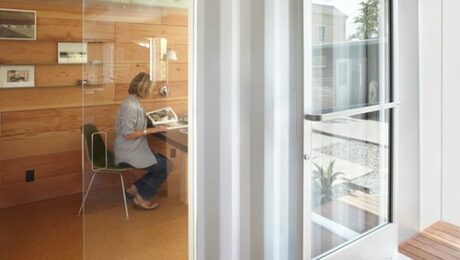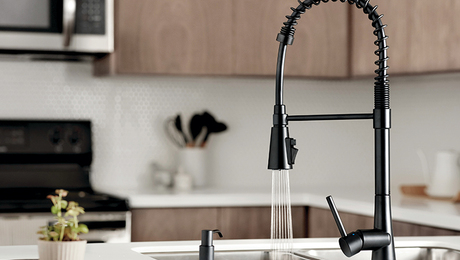Positioning Remote Bath Vent Fan in the Attic
Hi folks. I may be getting caught in the weeds here, but I’m sure an expert here can point me in the right direction…
Installing a Panasonic Whisperline 120 cfm remote bath fan in an attic to vent a 2nd floor master bathroom. The fan will be venting out of the gable vent, to avoid putting holes in the new roof. I have adequate soffit and ridge venting, and will block the gable vent except for the 4″ duct penetration to avoid pulling in any of the moist air I’m trying to vent.
I have two options for mounting the vent fan and routing the ductwork, as illustrated in the attached diagrams:
1. Mounted on top of ceiling joists
2. Suspended from rafters/ridge
If I go with #1, I can insulate the fan and most of the ductwork with the existing fluffy attic insulation. However, I’m concerned condensation could collect in the area indicated by the orange arrow due to the necessary vertical transition of the ductwork here to get up to the gable vent (about 4′ up).
If I go with #2, I would have to separately insulate the ductwork, but could have a straight run for the exhaust with a downward slope to ensure any condensation does run out the vent. There will still be some near vertical ductwork for the intake, and condensation could run down here, but at least it would drip into the conditioned space where I would see it.
Considering the ductwork will be insulated regardless of which route I take, am I overthinking the condensation concern here? Not pictured is the fact that I’ll be pulling intake from two locations, so #1 is certainly the path of least resistance and my highest chance of getting the details correct, so that’s where I’m leaning.
Thanks for any thoughts.
GBA Detail Library
A collection of one thousand construction details organized by climate and house part









Replies
Hi folks -- this was my post. I kept getting a 'Wordpress error' when attempting to post, so I tried again. Apparently it posted three times. Below are the attachments that were supposed to be in the original post, and moderators can please delete the other two threads.
I would go with option #2 and slope the exhaust toward the exterior for the exhaust with PVC.
Why are you exhausting it out the existing gable vent, rather than a vent termination lower down the gable wall so the entire run can be sloped to the outside and stay under the insulation?
Hi Malcolm,
That's a great idea, but not so easy in this case. The facade is brick, and the area lower down on the gable wall where it would terminate is awfully close to a garage that butts up against it. Aesthetically, it would look poor from the outside. I certainly appreciate the suggestion, and it's an option that I am going to mull over.
For what it's worth -- the previous bath fan utilized 4" flexible duct that ran down a rafter bay about 8', and then 90'd up to a vent termination in the roof -- all poorly insulated. The 90 was a perfect area to trap condensation, but when I removed it -- there were no signs of any standing water, mold on the adjacent sheathing, etc. That fan was used quite a bit, too. At least anecdotally, and perhaps because my roof assembly is quite vented, I'm wondering if my condensation concerns are a bit overblown.
Makes sense.
I agree with William. Use option two. Insulate the ducts. Any condensation will either run back down the vertical leg, or out the termination. What you don't want is a low spot for it to accumulate.
Option 2 will also help to keep the fan quiet by limiting transmitted sound IF you suspend it with something somewhat flexible (plastic strapping normally used for hanging PVC pipes is a good option). Between the flexible hangers, flex duct, and a loop in the power cable (you don't want a tight run), you have what amounts to vibration isolators between the fan housing and the rigid structure of the house. This can make a big difference in how quiet the unit is when operating.
Bill
Thanks, all. I am going to go with option #2 and will suspend with something flexible to limit vibrations.